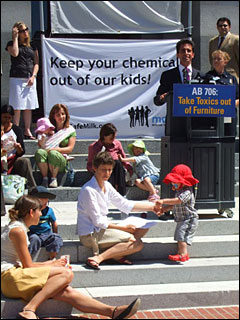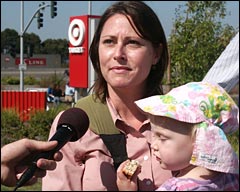
Concerned mothers and California Assemblyman Mark Leno rally support for their bill in May. (Photo by assembly.ca.gov.)
OK, so David slew Goliath. He never had half the battle facing Mary Brune and her fellow mothers in their crusade against the $500 billion-plus chemical industry.
In 2005, Brune and a trio of her friends in the San Francisco Bay area founded Making Our Milk Safe to raise awareness about the pesticides, lead, mercury, phthalates, perchlorate, PCBs, PBDEs, and other poisons invading human breast milk. Brune signed on as director and MOMS soon gained 600 members around the country — and political clout, too. This year, the group joined Friends of the Earth in the co-sponsorship of AB 706, a California measure banning the use of chlorinated and brominated fire retardants in furniture.
Toxic fire retardants, Brune knew, are the Frankensteins of the furniture world: rising up from countless foam-stuffed couches, chairs, and other products, they drift invisibly into household air and dust, making human exposure inevitable. Chlorinated fire retardants are so dangerous they were banned in children’s sleepwear nearly 30 years ago, only to show up again in furniture. Polybrominated diphenyl ethers, or PBDEs, are equally odious — and have been measured in North American women at levels higher than anywhere else in the world.
Against this backdrop, San Francisco Assemblyman Mark Leno (D) introduced AB 706 in February. The bill was dubbed the Crystal Golden-Jefferson Furniture Safety and Fire Prevention Act, in honor of a Los Angeles-area firefighter who died of work-related non-Hodgkins lymphoma (it’s a common cause of cancer in firefighters, owing to the poisonous smoke produced by fire-retardant-treated materials when they burn).
Firefighters across the state supported the legislation. But all forward motion ceased this summer when a group called Californians for Fire Safety kicked off a multimillion-dollar anti-AB 706 campaign, bankrolled by world leaders in the flame retardant business: Virginia-based Albemarle Corp. (annual sales of $2.4 billion); Connecticut-based Chemtura Corp. (annual sales of $3.5 billion), and Israel-based ICL Industrial Products, considered the globe’s top producer of bromine.
On Sept. 12, the California Senate bowed to the wishes of the chemical-industry lobbyists hovering in the wings and put Leno’s bill into deep freeze for 2007; it can be reintroduced in 2008. We caught up with Brune to find out why she got involved in this fight — and how it feels to be potentially facing round two.
Q. At first, AB 706 almost looked like a slam dunk. What happened?
A. The chemical industry kicked off a huge campaign: glossy mailers to registered voters, robo-calls, television ads, full-page ads in the major newspapers. We estimate they’ve spent $5 million to $10 million to defeat the bill. By comparison, we spent $5,000 on our video [watch it below]. It’s been a small, grassroots effort by our members and our allies at Friends of the Earth and MomsRising.
Q. Your opponents said fire retardants are needed to save lives. How do you answer that?
A. The main culprit in fire deaths is smoldering cigarettes; that’s why California mandated flame retardants in furniture 30 years ago. But today, smoking is down in general, we have a law in California requiring that cigarettes be self-extinguishing, and we have smoke detectors and other improvements. And there are other products available — wool and polyester fillings, for example — that are affordable and just as effective as the brominated and chlorinated flame retardants, and they’re also nontoxic. There’s no need to be choosing toxic chemicals when there are safe alternatives.
Q. Cosponsoring a bill is heavy lifting. What made you sign on?
A. Naiveté? [Laughs.] No, actually it was perfect for us. There have been increasing studies over the years linking toxics in breast milk to health problems. And PBDEs had been found in babies’ cord blood. But this May a new study published in Environmental Health Perspectives [PDF] specifically looked at the level of flame retardants in breast milk and a particular type of birth defect, undescended testicles in baby boys. And one of the causes was the endocrine-disrupting effect of PBDEs.
In Sweden, they have fantastic bio-monitoring data that goes back about 30 years. In the ’90s the studies showed that levels of PBDEs in breast milk were doubling every five years. Because of that, companies in Sweden were asked to stop using these chemicals and, as a result, there was a decline of PBDE levels in Swedish mothers. Getting rid of the chemicals in commerce was proved to be an effective way to decrease levels in breast milk.
We also wanted to bring a human face to the campaign. We were nursing moms who were really doing this for our children, because kids are at risk. So far there isn’t any study that shows that any of these chemicals are safe.
Q. Doesn’t the chemical industry say they’re safe?
A. Yes, they do, and I’m not sure how they say it with a straight face. But as far as I’m concerned, as a parent we take precautionary measures to protect our children every single day. We use car seats, we put safety locks on our cabinets. So when we know that something children come into contact with every day — beds, couches, mattresses — is dangerous and could seriously hurt them, we have to do something about it.
Q.You can’t see PBDEs coming out of your couch cushions. You can’t feel them mutating your cells. Does that make it hard to convince people that the chemicals are dangerous?
A. When I was a kid, I lived in a community where there was this bug truck that would ride around at night spraying insecticide, and my sisters and I would run through the spray and play. No one knew what the spray was. My one sister had a hysterectomy at 33, my other sister has never been able to conceive, and I had a hard time getting pregnant and might never have another child. Very few people would trade their futures if they knew the risk they were taking — if they knew what these exposures could do.

Mary Brune protests at Target in fall 2006. (Photo by Gregory Dicum.)
Q. Who are your chief opponents?
A. Three companies — Albemarle, Chemtura, and ICL Industrial — are the main manufacturers of these chemicals right now. But they’re not saying, “Given the fact that kids are at risk, let’s use our dollars to produce the least toxic fire retardants we possibly can.” They’re not saying, “Let’s take $10 million to try and keep children safe.” Instead, they’re using $10 million to try and stop a safety bill from becoming law. I hope that the public will start to see these tactics and see that it’s our health that’s at stake.
It’s staggering when you consider that our aggregate exposure to all the synthetic substances in our environment could be the underlying cause of so many diseases and developmental problems — just look at the increases in cancers, infertility, autism. What it boils down to is that companies should not be able to put things on the market without regard to what the end result will be. We need to make sure things are safe before we put them out there.
Q. What should nursing mothers do?
A. Breast milk is still the best choice for kids. That, we feel very strongly about. But we need to speak up in the marketplace and in legislation, and we need to tell corporations and politicians that it’s not OK that toxic chemicals in the environment are ending up in breast milk. It’s a violation of our rights.
The idea that toxic chemicals have gotten into our breast milk — that what should be the purest food on the planet has become poisoned — that’s something almost unthinkable.


